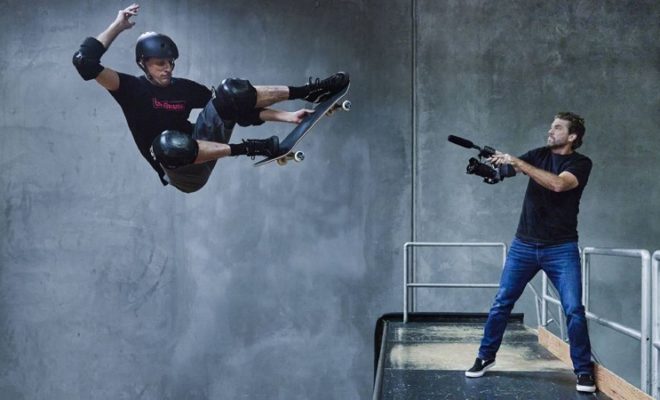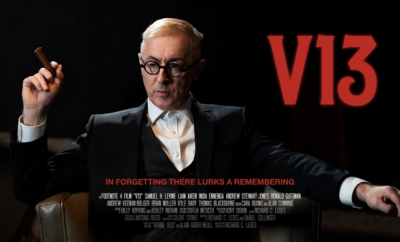
Movie Reviews
Tony Hawk: Until the Wheels Fall Off
By: Kelly Kearney
“It was like Luke Skywalker going to take out Darth Vader at the death star,” said legendary promoter and skater Stacy Peralta about the time his young protégé Tony Hawk stole the show from the hometown favorite. That winning moment, one that stunned the sport and catapulted the trick master, his name and even his face, into every home in America was the beginning of Hawk’s successes. Four decades later that fire to be better still burns bright in “The Birdman” today. The Duplass brothers’ production directed by Sam Jones, Tony Hawk: Until the Wheels Fall Off offers up an in-depth peek at how the greatest skateboarder of all time rose to fame and inspired multiple generations to grind their way through the asphalt of life. Told through personal interviews with Hawk, his family, friends and colleagues we see how the king of catching air turned his personal challenges into a wheels in the air artform, even when facing every obstacles attempting to hold him down.
According to Hawk, “Failure is all in the mind.” And that’s why Tony stays focused on conquering each trick like a marathon he hopes he never finishes. At the age of fifty-three, he is still a work in progress as we watch him try and fail to land a trick that will leave you squinting every time his body comes crashing down on the vertical ramp. No matter how many times he winds up eating wood face first, the legend gets back up and tries it again. It’s his drive to be better than before that his brother remembers most when talking about a young Tony – too small for other sports and too young to play with the big kids. The toe-headed baby of the family had nothing in common with his older siblings until one fateful day, after annoying his brother and his skateboarding friends, Tony picked up a spare deck and was determined to figure out how to ride. Tony himself admits the first time wasn’t some life defining “choirs of angels moment.” The master of the decks, ironically, couldn’t even make the wheels stop. Now, his brother points out, that same board he first stepped on sits in the Smithsonian Museum for all to see.
Filled with clips from his early days skating, including the time he stole the show at the Oasis skatepark and the Del Mar competitions when he landed his first successful McTwist, the documentary does a superb job of painting a picture of a hardworking underdog without ever shying away from his failures. Tony, the perfectionist whose teen anger dissipated once he successfully maneuvered a trick, was the young no-name kid who got the career boost he needed when he met Stacy Peralta – a man who saw something in this skinny kid when everyone else in The Bones Brigade did not…at least at first. But it was that determination to learn that Stacy remembers most. When talking about his Bones Brigade skate team, Stacy gathered some of the most talented athletes in the sport with the dream of taking it out of the abandon pools of Southern California and into the homes and minds of every kid in America. He needed a star with a sellable face and bag of tricks and at the time the leader of the pack was skating legend Christian Hosoi, a skilled airman in his own right that even had Tony in awe. Hosoi was the elite name in the sport, unlike the scrawny blonde kid with behavioral issues and a kick-flip ollie nobody saw coming – and even more were outraged over. Tony didn’t land on the skate fans’ radar lining up to see Christian ride until one fateful competition when Hosoi pulled out leaving an opening for Tony to grab everyone’s attention.
In interviews with fellow skaters and champions like Steve Cabellero, Lance Mountain, Hosoi and Mike McGill we hear about what it was like to watch this tiny boy turn into a competitor – threatening to take every trophy the sport had to offer. Stories of sibling-like torment they put a young Tony through (being forced to eat the gum from in between Caballero’s toes) and the verbal beat downs he got after winning the Del Mar skating tournament not only touched on the jealousy the older riders had for him, but highlighted Hawk’s ability to block out the noise and just do what he loved to do. There were accusations of cheating when he came up with seemingly impossible tricks or caught air higher than anyone before him by inventing a new kick-flip technique rather than using muscle power. His physical setbacks became his biggest motivator and instilled a need in him to win; not just to prove himself to the other riders in the sport but to prove it to himself. Skateboarding was what he was good at and good, wasn’t ever going to be enough. It was either the best he can be or try again tomorrow. With every new trick conquered another idea was born and his Innovation partnered with an unquenching thirst for more air, more flips and harder landings forced the sport to meet him at the height of his talents and not the other way around.
After the death of his father and subsequent lonely existence living in an empty house at the age sixteen, Tony quit professional skating because winning just became too boring, mechanical and lacked the creative drive that kept pushing him forward. When you’ve won every trophy, traveled the world and your face is now a commodity what else is there left to do at that age? It took leaving the competitive life for Tony to fall back in love with skating and take it to the next level by carving a new career out of the one he already conquered. The ‘80s skate culture found a rebirth when video games and Tony Hawk was once again a household name. Tony Hawk’s Pro-Skater was the hottest game on the market and with it many sequels and merchandising to follow. He reinvented his brand at a time when skating went out of fashion and rollerblading was all the rage. He is, and seemingly always will be, a work in progress.
Tucked in among the interviews, both past and present, and highlights from The Bones Brigade and Thrasher videos that were popular in the mid to late 80’s, the undisputed King of the Vertical Ramp also spends quiet moments in the documentary reflecting on his ailing mother, the role his deceased father played in coordinating the National Skateboarding Association and the friends and loved ones he made and lost along the way. Aside from the clips tracking his career, the documentary heavily features his friends and contemporaries in the sport, all of whom not only praise his accomplishments but equate their own to his inspirational rides.
Picasso painted from his death bed, so it makes sense that at fifty-three years old Hawk would still be taking those bone crushing falls, which some might view as crazy – something his friends certainly do. Over the years Tony’s focus, or what some might call obsessions, did become a detriment to his body as well as his personal relationships. Director Sam Jones makes sure to show the glory and the agony of fame and success…four marriages with four children who were pushed to the background while he built his career around skating appearances, video game promotions and touring to keep his brand fresh and profitable. Talking openly about the mistakes he made staying hyper focused on his career, today Tony seems to be working hard at keeping those two parts of his life separate.
A moment that stands out in the film the most comes when he delves a bit into his emotional and financial struggles on the heels of the sport’s declining popularity. It forced him to sell the house he bought at age seventeen and dismantle his massive at-home vertical training ramp. The entire story appears to gut him worse than any failed landing. Quitting seems like an impossibility for him. In fact, he might be genetically incapable of it. So, it is heartbreaking to watch him face the very real possibility that age and pop culture might force him out of the sport long before he is ready to say goodbye. But. as we saw in the opening sequence, if he can stand then he can fly, so I wouldn’t count him out just yet, even with his current broken leg sidelining him right before the release of this documentary.
Along with the video clips and interviews director Sam Jones, with the help of Editor Greg Finton, sets the stage for that 70’s and 80’s skate or die movement by infusing artists from the punk and new wave genre that were key proponents to driving the skating scene. Both subculture movements partnered with MTV, the invention of the VHS player and the underground current of artists meshed into one distinctly Southern California pop culture phenomenon was an important detail Jones made sure to include. You can’t have Tony Hawk without The Bones Brigade and you cannot have the attitude of the Brigade without skating to some thrashing music. The music, the fashion and the merchandising were as much a part of Hawk’s fame as that shocking 900 that he landed at the X Games in 1999.
In moments when the film flips from the personal accounts of Hawk’s life to the much broader subjects of skate park demolitions, the legality of skating in public or Peralta’s push for VHS domination can feel a bit jumpy and out of sorts but not overly distracting. Where the film shines is in the interviews with friend and fellow rider, Rodney Mullins. Where Tony can seem a bit guarded in his interviews Mullins, like the other skaters who gave their time to the film, is an open and inspiring book. With his soft, almost poetic takes on the art of skateboarding and the artist known as Tony Hawk, he looks deeply into the camera and gives us that ah-ha moment when he admits he “is not going to give it up until the wheels fall off.” That is what Tony’s peers worry about when it comes to the overly driven icon. As Tony gets older, he keeps pushing himself to go for harder tricks and longer training sessions, but Mullins gets it. Hawk’s drive is as much an artform as any blind landing he could pull off. They are inventors, harnessing the wind, manipulating gravity and forcing it to their will. It is an addiction as much as it is a wonder to witness and, as we saw in the opening minutes, Tony’s fiery desires to improve on his very best burns as hot in him as ever. Fail after screaming fail he gets up and tries again because the glory isn’t just in landing the trick – it’s in the journey he takes to get there. Tony Hawk has been a household name for four decades and in that time he never once took his eyes off the wheels; they’re firmly planted beneath him, always ready to ride. That troubled kid found where he belonged – that thing that made him special – and it gave him a family and place among the greats in sports. He is his own creation, like any artist who paints their story on canvas, and like all creators that light of inspiration does not go out. It just burns brighter as the work gets harder.
With its two-hour time run, Tony Hawk: Until the Wheels Fall Off keeps you entertained for the full run without ever fluffing the run time with superfluous content. If you love sports documentaries, were an X Games fan or you caught your own air during those early Bones Brigade days, this biographical watch is filled with all the nostalgia you could ask for. Give it a spin and you just might find yourself dusting off those old wheels in honor of The Birdman who is still teaching us new ways to fly today.




You must be logged in to post a comment Login